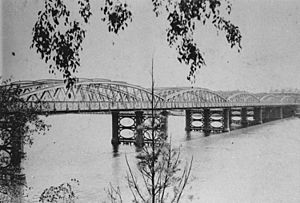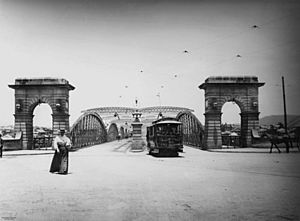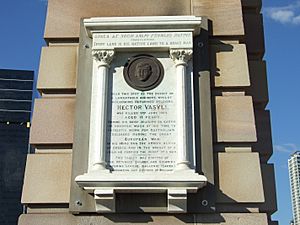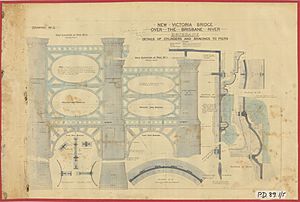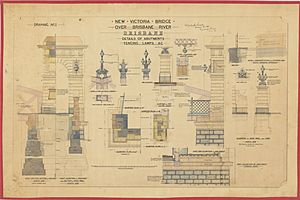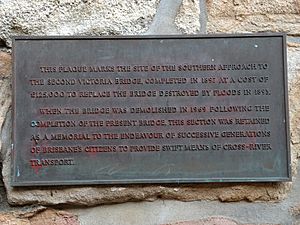Victoria Bridge Abutment facts for kids
Quick facts for kids Victoria Bridge Abutment |
|
|---|---|
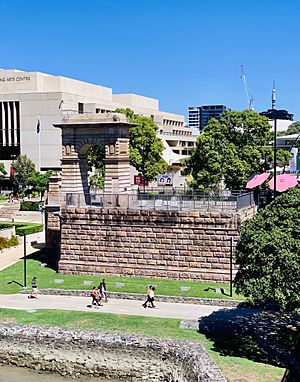
Victoria Bridge Abutment, 2019
|
|
| Location | 74 Stanley Street, South Brisbane, City of Brisbane, Queensland, Australia |
| Design period | 1870s - 1890s (late 19th century) |
| Built | 1896 |
| Architect | Alfred Barton Brady |
| Architectural style(s) | Classicism |
| Official name: Former Victoria Bridge Abutment | |
| Type | state heritage (built) |
| Designated | 21 August 1992 |
| Reference no. | 600303 |
| Significant period | 1890s (fabric) 1896-1969 (historical existence of bridge). |
| Significant components | wall/s, plaque, memorial - tablet, abutments - road bridge, tramway, bollards, furniture/fittings, archway, kerbing and channelling |
| Builders | Arthur Midson |
| Lua error in Module:Location_map at line 420: attempt to index field 'wikibase' (a nil value). | |
The Victoria Bridge Abutment is a special part of an old bridge in South Brisbane, Australia. It's what's left of the fourth Victoria Bridge that crossed the Brisbane River. This part was built in 1896. It was designed by Alfred Barton Brady, a Queensland Government Architect. The stone work was done by Arthur Midson. This abutment is important because it shows how bridges were built long ago. It also holds a special memorial for a boy named Hector Vasyli.
A Bridge Through Time
The Victoria Bridge Abutment is a piece of history. It comes from the second permanent bridge built here. This bridge was made of iron, with strong stone supports called abutments. The abutment you see today is a large stone base. It supports a piece of the old road and a stone archway. This archway has fancy neoclassical decorations.
The Bridges of Brisbane River
Many bridges have crossed the Brisbane River at this spot. The very first one was made of timber in 1865. But it only lasted two years because of damage from sea worms. A more permanent bridge started being built in 1864. It finally opened in 1874. This bridge was named Victoria Bridge after Queen Victoria. People had to pay a toll to cross it until 1877.
Sadly, this bridge was destroyed in big floods in February 1893. A temporary bridge was put up quickly. But it was also washed away by floods in 1896. Luckily, the second permanent Victoria Bridge was almost finished by then. The first half of this new bridge opened in September 1896. The whole bridge, including tram lines, opened in June 1897.
How the Bridge Helped Brisbane Grow
The opening of the first permanent Victoria Bridge in 1874 was a big deal. It connected the north and south sides of the river. This helped the south side of Brisbane grow a lot. In the 1880s, South Brisbane became very busy. New things like the South Brisbane Dry Dock opened. Coal wharves and train lines were built. The South Brisbane railway station became a main train stop.
Businesses and people moved to the area. Stanley Street became a busy shopping area. Homes were built on hills with river views. The South Brisbane Municipality was created in 1888. Important buildings like the Town Hall and Post Office were built. The bridge even had a part that could swing open. This allowed tall ships to pass through. But later, it was closed permanently for tram tracks.
Fun Stories About the Bridge
The Victoria Bridge was very important to the city. Here are two fun stories about it. When the bridge opened in 1897, both North and South Brisbane wanted a celebration. So, they had an opening ceremony on the north side. Then, important people crossed the bridge for another ceremony on the south side. After that, they crossed back for refreshments!
Another story is about a prank by university students in the 1930s. One morning, they put up "bridge closed" signs at both ends. Police saw the signs and stopped cars from using the bridge all day. It caused a lot of problems for businesses. The students got into big trouble for their joke.
Building the Bridge
The design of the 1896 bridge was very impressive. The engineers had to solve tricky problems. The river banks were at different heights. But the bridge was built so smoothly you couldn't tell. The strong iron pillars supporting the bridge were made in Queensland. Workers had to build deep underwater. Some even got sick from "the bends," a problem from working under pressure.
The bridge had separate lanes for traffic. There were two lanes going in each direction. The middle part of the bridge had metal lattice work. Stone pillars with gas lights marked the ends of this divider. Pedestrian walkways were on both sides of the main road. Until the 1930s, this was the only permanent bridge across the Brisbane River.
As more cars used the bridge, it became very crowded. So, new bridges were planned. The William Jolly Bridge was built first. Then came the Walter Taylor Bridge in Indooroopilly. The Story Bridge opened later in 1940.
The Hector Vasyli Memorial
In 1918, a sad event happened during celebrations for the end of World War I. An 11-year-old boy named Hector Vasyli was killed. He was hit by a vehicle during a parade welcoming soldiers home. Hector was of Greek background. A marble tablet was put on the bridge to remember him. Every Anzac Day, a special service is held there for him.
When the bridge was taken down in 1969, the memorial tablet was carefully removed. The Greek Community and Brisbane City Council decided to keep this part of the bridge. They wanted to make sure Hector's memorial had its original place. The tablet was put back on April 24, 1970. A bronze picture of Hector on the tablet had been lost. But Hector's sister helped by providing a photo. A new picture was made from it.
After the bridge was taken down, the abutment was left as a ruin for a while. But it was fixed up for World Expo 88. This big event was held at South Bank Parklands. Two bronze plaques were added to the abutment then. They tell the history of the bridge.
What the Abutment Looks Like
The Victoria Bridge Abutment is on the south side of the Brisbane River. It's next to the current Victoria Bridge. It's a big stone structure. The stone has a rough, "rock-faced" look. The top part has the old tram tracks.
The archway where people walked is made of cut stone. It mixes old Greek and Egyptian styles. The pillars supporting the arch get narrower at the bottom. Above the arch, there are decorative stone bands. These bands once held fancy metal brackets for gas lamps. These lamps lit up the bridge entrance.
The Hector Vasyli memorial is on the side of the arch. It's a marble tablet shaped like a small temple. It has columns and a round picture of Hector. The words on the tablet tell his story. They say he was a brave boy who helped Australian soldiers.
Below the tablet, there are metal hooks. These might be for holding wreaths during Anzac Day services. A metal post, called a bollard, is also still there. A section of the old road with tram lines remains. There's also a low concrete platform.
The abutment is now separate from the rest of the bridge. New supports were added to keep it safe. There's a white safety railing around it. Stairs were also added so people can visit. Two bronze plaques are on the stairs. They explain the bridge's history.
- Plaque one (ground level) says: "This plaque marks the site of the southern approach to the second Victoria Bridge, completed in 1897 at a cost of £125,000 to replace the bridge destroyed by floods in 1896. When the bridge was demolished in 1969, following the completion of the present bridge, this section was retained as a memorial to the endeavour of successive generations of Brisbane's citizens to provide swift means of cross-river transport."
- Plaque two (first landing) says: "This stonework is all that remains of the first permanent bridge to span the Brisbane River. A temporary wooden structure was erected in 1865 as staging for the permanent bridge, but was closed to traffic from Nov 1897 as a result of flood damage. On the 15th June 1874 the new bridge was opened and named Victoria Bridge. The northern section of the Victoria Bridge collapsed on 6 February 1893 under pressure from debris during the disastrous flood of that year."
Why This Place is Special
The Former Victoria Bridge Abutment is listed on the Queensland Heritage Register. This means it's a very important historical site.
A Piece of Queensland's Past
This abutment shows how Queensland's history unfolded. It's a reminder of the first strong bridge that survived the river's floods. When the bridge opened in 1897, it really helped South Brisbane grow. It continued the important link between the north and south sides of the river.
Learning from the Design
The design of the abutment tells us about the style of early public buildings in Brisbane. It also shows how engineers solved tough problems. For example, they had to deal with different river bank levels.
Its Beauty and Style
The elegant design of this remaining part reminds us of the beautiful bridge. It was designed by A B Brady, a very important architect.
Important to the Community
The Victoria Bridge Abutment is very special to the Greek community in Brisbane. It holds the memorial for Hector Vasyli. He was a young Greek Australian boy who died showing his loyalty to Australia. The Greek community worked hard to make sure this part of the bridge was saved. They wanted a proper place for Hector's memorial. They still hold a special service for him every Anzac Day.![]() This Wikipedia article was originally based on "The Queensland heritage register" published by the State of Queensland under CC-BY 3.0 AU licence (accessed on 7 July 2014, archived on 8 October 2014). The geo-coordinates were originally computed from the "Queensland heritage register boundaries" published by the State of Queensland under CC-BY 3.0 AU licence (accessed on 5 September 2014, archived on 15 October 2014).
This Wikipedia article was originally based on "The Queensland heritage register" published by the State of Queensland under CC-BY 3.0 AU licence (accessed on 7 July 2014, archived on 8 October 2014). The geo-coordinates were originally computed from the "Queensland heritage register boundaries" published by the State of Queensland under CC-BY 3.0 AU licence (accessed on 5 September 2014, archived on 15 October 2014).


